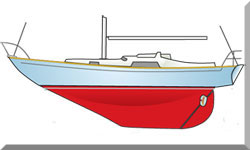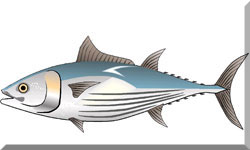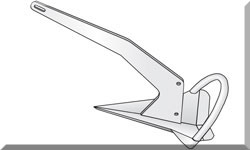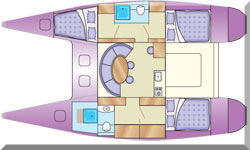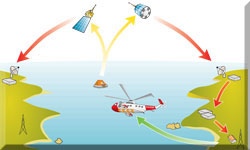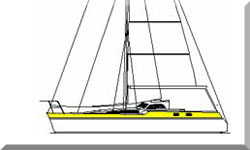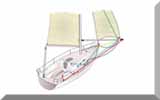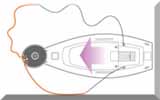- Home
- Offshore Seamanship and Heavy Weather Tactics
- Optimal Watch Keeping Systems
Optimal Watch Keeping Systems: Rotas for Rest, Safety & Vigilance on Passage
In a Nutshell...
Optimal watch keeping systems aren't just about ticking off a box for the COLREGS (specifically Rule 5: Look-out); they're the absolute foundation of safety, rest, and good seamanship on any offshore run. For us on small sailing yachts, a well-managed rota is vital for keeping fatigue at bay—the biggest risk we face. A solo sailor can, and must, lean heavily on electronics (like AIS and radar alarms) to cut the risk, but any crew of two or more needs a rota they all stick to. The five-watch, rotating-night pattern is a favourite for two-handed crews, as it makes sure everyone gets equal, quality sleep over two days. Non-negotiables are effective handovers, clear skipper rules on when to call for help, and always clipping on. This is how we build trust and prove our expertise.
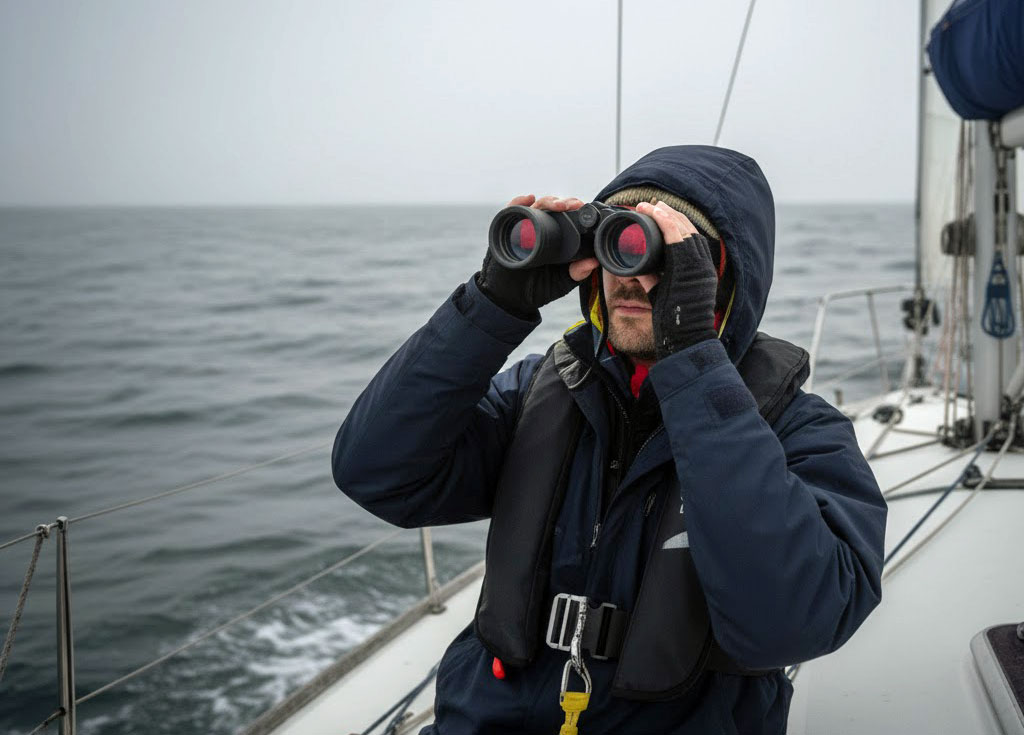 "I see no ships" (with apologies to Lord Horatio Nelson )
"I see no ships" (with apologies to Lord Horatio Nelson )Table of Contents
- The Immutable Law of the Sea: COLREGS & Look-out
- The Solo Sailor's Dilemma: Mitigating Risk with Technology
- Designing the Optimal Watch Keeping Rota
- The Human Element: Combating Fatigue & Maintaining Vigilance
- Beyond the Horizon: The Watch Keeper's Full Remit
- Integrating Weather & Watch Tactics
- The Psychology of Delegation & Trust
- Contingency Planning: Watch Keeping Under Duress
- Skipper's Protocols & Non-Negotiable Rules
- Summing Up
- Frequently Asked Questions (FAQs)
Having done a fair bit of solo and short-handed sailing, I can tell you that the notion of 'turning in at sundown' and leaving a small yacht to its own devices on the ocean is sheer folly. It's a gamble that might pay off for a hundred passages, but when it doesn't, the consequences are terminal. The world’s oceans, even outside the main shipping lanes, aren't empty. Our sailing yachts are tiny, almost imperceptible dots compared to the container ships and tankers that charge along—vessels that wouldn't feel the slightest bump if they ran you down.
Not keeping a diligent watch on passage isn't just plain foolish; it’s a profound breach of Maritime Law and basic seamanship.
The Immutable Law of the Sea: COLREGS & Look-out
At the heart of any argument for watch keeping is The International Regulations for Preventing Collisions at Sea (COLREGS). It's a mandatory code that dictates the behaviour of every vessel afloat.
Specifically, Rule 5, Look-out, couldn't be clearer:
'Every vessel shall at all times maintain a proper look-out by sight and hearing as well as by all available means appropriate in the prevailing circumstances and conditions so as to make a full appraisal of the situation and of the risk of collision.'
"At all times" means exactly that: 24 hours a day, in all weather. For an offshore sailor, following this rule is the clearest measure of their professional attitude and trustworthiness.
The Solo Sailor's Dilemma: Cutting Risk with Technology
Truth is, a true solo sailor can't, by definition, stick to the strict letter of Rule 5. They can't maintain a proper look-out by sight and hearing at all times when they absolutely have to sleep.
However, modern single-handers must do everything possible to comply with the spirit of the COLREGS by using smart electronic systems. This, of course, hinges on having a reliable and robust charging regime to keep everything humming 24/7.
Here are the essential electronic watch systems used by experienced solo sailors:
- AIS (Automated Identification System) Alarms: This system is absolutely critical. You can set the alarm for a minimum Closest Point of Approach (CPA) and Time to Closest Point of Approach (TCPA). If an AIS-equipped vessel crosses those limits, the alarm shouts out and alerts the sleeping skipper.
- Radar Alarms: These pick up non-AIS vessels, fishing boats, land masses, and nasty environmental hazards like icebergs or squall lines. Modern broadband radars are brilliant at short range.
- Integrated Instrument Systems: You can set these to sound an alarm if the boat drifts off course, if the apparent wind speed or direction suddenly changes, or if there are unexpected shifts in boat speed or water depth.
These gadgets are great aids, but they're still just aids. Many solo sailors rely on a simple kitchen timer to wake them every 15-20 minutes for a quick 360-degree sweep of the horizon. It’s not perfect, but it’s a necessary compromise. Remember, all the tech in the world won't save a tired crew.
Designing the Optimal Watch Keeping Rota
A watch keeping rota is all about juggling two opposing needs: vigilance and rest. The system has to deliver enough quality sleep to the off-watch crew while making sure the person on watch is sharp and effective. Crew size usually dictates the best approach.
Crew of Two: The Art of Rotation
Most cruising boats are sailed by a couple. The main headache for a crew of two is managing those long, dark, and often exhausting night hours. To ensure both crew members get decent, equal rest over the course of the passage, the system has to rotate who gets the 'worst' (the blackest part of the night) watches.
Here are the four most common options, all of which use an odd number of watches to ensure the rotation happens over a two-day period:
| Rota & Option | Watch Period Structure | Key Benefit | Experienced Insight |
|---|---|---|---|
| Option 1 (Favoured System)* | Five watches in 24 hours (e.g., 4, 4, 4, 6, 6-hour watches) | Equalises the night burden over 48 hours & ensures a long 6-hour off-watch day rest. | This system, which Mary and I used crossing the Atlantic, works because the 6-hour day break allows for deep sleep and core domestic duties. |
| Option 2 (The ‘Dread’ Split) | Five watches in 24 hours, but splits the blackest part (2100-0300) into two shorter 3-hour watches. | Shorter watches during the period of maximum fatigue. | Can lead to fragmented sleep if the crew member is 'up' twice in a short period. |
| Option 3 (Higher Frequency) | Seven watches in 24 hours (e.g., shorter watches overall) | Reduced fatigue on individual watches. | More disruptive to the sleep cycle. The crew is called upon more often. |
| Option 4 (Shortest Period) | Nine watches in 24 hours (2-hour watches around midnight) | Maximum single-watch vigilance. | Not recommended for long passages; the sleep penalty is too high, leading to cumulative fatigue. |
*That 6-hour day watch for a two-person crew (Options 1 & 2) is often used for essential maintenance, cooking a proper meal, or just relaxing and enjoying the journey. It’s a vital period of daylight recovery.
Crew of Three: The Luxury of Choice
With an extra person aboard, the burden is seriously eased. The day is usually split into an even number of watches to create a three-day rotation, ensuring all three crew members share the load equally.
| Rota & Option | Watch Period Structure | Key Benefit | Focus |
|---|---|---|---|
| Option 1 (Simple 3 on/6 off) | Eight 3-hour watches in 24 hours. | Guaranteed 6 hours off-watch every time. | Excellent for long passages where deep, restorative sleep is paramount. |
| Option 2 (The Extended Break) | Eight watches, tweaked to provide one long 8-hour period off watch. | Provides a significant break for the crew to perform maintenance or socialise. | Requires flexibility in the watch periods, which may not suit everyone. |
The Human Element: Combating Fatigue & Maintaining Vigilance
The real threat to effective watch keeping isn't poor discipline; it's cumulative fatigue. Even with the best rota, the constant motion, noise, and low-level tension will wear down performance. A true professional doesn't just put up with sleepiness—they tackle it head-on.
Understanding Circadian Rhythms
You've got to understand your body’s natural clock. Alertness is highest late morning and early evening, and then dips sharply, typically between 0300 and 0500. This is your 'window of maximum risk'. If you can put your most experienced or freshest crew member on the watch that hits this low point, you're already safer. Don't expect top-notch thinking during these hours; keep the tasks simple.
Active Countermeasures for Monotony
On a long, calm ocean stretch, the mind can wander—a dangerous state called monotony-induced fatigue. To fight back:
- Controlled Power Naps: If you're seriously struggling, a quick, supervised 20-minute power nap in the cockpit, with the off-watch crew standing right next to you, can reset you. Go over 20 minutes, though, and you risk waking up completely groggy.
- Varying Your Focus: Don't just stare at the radar screen. Force yourself to look right around the horizon every five minutes. Pick up the binoculars and inspect a quadrant, even if it seems empty.
- Cognitive Tasks: Keep the brain ticking over. Hand-steering for 15 minutes, reading chart notes out loud, or even listening to a spoken-word radio show (with one ear open for alarms) can keep you active without distracting you from your primary duty.
Beyond the Horizon: The Watch Keeper's Full Remit
The person on watch isn't just a look-out; they are the acting Master of the vessel. Their responsibilities cover the boat's health and integrity, too.
Routine Vessel Checks (The 'Walk-Round')
Every two hours, or at least once during a four-hour watch, the keeper should do a quick, disciplined check:
- Rig & Sail Check: Look up and visually inspect the mast and rigging. Check for new signs of chafe on the running rigging, make sure the primary sheet is holding, and confirm the tell-tales are flying properly. A change in the sound of the sails often tells you something is up.
- Engine & Bilge Monitoring: If the engine is on (for charging or motoring), check the panel for correct oil pressure and temperature. Open the main bilge access hatch for a rapid visual check for water.
- Below-Deck Systems: Check the charging system output (amps in vs. amps out) to ensure the batteries are happy. Briefly feel for excessive heat from the fridge compressor or other electronics.
- Weather: Check the barometer reading and note any significant changes since the last handover.
Navigation & Communication Discipline
- Plotting Discipline: Even with a high-tech chart plotter, a physical position must be logged every three hours, along with course and speed. This builds system redundancy and keeps you connected to the vessel's progress.
- Radio Watch: Keep listening on VHF Channel 16 and, especially near the coast, on the relevant working channel. Also, monitor the NAVTEX or satellite systems for incoming Maritime Safety Information (MSI).
Integrating Weather & Watch Tactics
A time-based rota works when things are steady, but a weather-based strategy is what separates the novices from the pros. You have to be ready to match your human resources to the environmental risk.
- Shifting to Double Watch: If your radar or forecast predicts a strong cold front or squall line hitting within the next couple of hours, you must call the skipper and suspend the rota. A double watch (two people in the cockpit) is essential for rapid reefing, sail changes, and keeping an extra eye on traffic. Don't wait until the boat is struggling.
- Heavy Weather Watch: When you're dealing with gales or nasty sea states, shorten those watch periods—sometimes down to 90 minutes on/3 hours off. This is purely to minimise the time any single crew member is exposed to potential injury and extreme physical exhaustion, guaranteeing maximum focus during their short spell.
- Low Light Vigilance: Pre-dawn and pre-dusk are the hardest times to spot unlit vessels, floating trash, or the true shape of an incoming wave. These periods demand your absolute highest focus, regardless of where they fall in the schedule.
The Psychology of Delegation & Trust
The principles discussed here—rest, vigilance, and clear communication—are the foundation of crew safety. For a deeper understanding of how these watch-keeping tactics fit into the wider context of vessel management, preparing for heavy weather, and developing crew cohesion, you'll need to master the overall strategies detailed in our comprehensive guide to Mastering Offshore Seamanship & Safety: Protocols, Heavy Weather & Crew Tactics.
Watch keeping protocols live or die based on the skipper's confidence in the crew. Building and maintaining this trust is crucial for the skipper's rest and the entire crew's morale.
- Competency through Hand-Over: The off-watch crew mustn't just assume the incoming person heard them. The on-watch crew must actively confirm their understanding of the boat's status, traffic, and any current system issues. Trust is built on this clear information exchange.
- Delegation Confidence: The skipper must be clear about the watch keeper's decision-making power. If the wind jumps up 5 knots, the watch keeper should have the authority to put a reef in immediately—not wait to call the skipper. Clear, agreed-upon parameters cut out hesitation and build autonomy.
- Post-Watch Debrief: A quick, non-judgemental chat after the watch about any minor incidents, close calls, or system anomalies is a fantastic learning tool. This stops small mistakes from growing into bigger ones and shows the skipper respects the watch keeper's observations.
Contingency Planning: Watch Keeping Under Duress
The ultimate test of an Optimal Watch Keeping System is how it holds up when your crew is suddenly cut down by sickness, injury, or when the off-watch person is needed for a serious repair.
- Immediate 'Buddy' Activation: If the on-watch crew needs help with a repair (say, pumping or fixing a serious chafe point), the off-watch crew must be immediately woken. The focus shifts to stabilisation. The injured or sick crew member remains off-watch, and the remaining capable person(s) must adapt instantly.
- The Short-Term Solo Rota: If you are effectively down to one capable person, you must switch immediately to the Solo Sailor Protocol (see above). This means leaning entirely on electronics, setting the autopilot with extreme care, and sticking to the alarmed view of the horizon every 15-20 minutes. Forget non-essential tasks—they don't matter right now.
- Medevac Watch Priority: If a crew member is seriously hurt and a medical evacuation or major system repair is underway, the watch priority is no longer about speed or comfort. It is purely about vessel stability, position reporting, and maintaining radio watch. You must preserve the boat's state to ensure you can receive help.
Skipper's Protocols & Non-Negotiable Rules
The Skipper needs to trust the on-watch crew completely to get a decent, undisturbed rest. That trust is built on a clear set of rules that must be followed every time. These are the non-negotiable standards of expertise and safety:
- Tethering: The watch keeper must remain clipped on at all times, day or night, when out of the cockpit. The sea doesn't offer second chances.
- Going Forward: No watch keeper shall go forward of the cockpit without first waking and alerting at least one other crew member. A simple tether won't be enough to recover a solo person from the bow.
- Collision Course: Call me immediately if we look like we're heading for a collision (CPA less than 1.5 miles and TCPA less than 20 minutes) or if you see a light you are unsure of. Dealing with it early is everything.
- Reefing & Sail Plan: Call me if you have any doubt about the sails or think it's time to reef. I'd rather be woken for nothing than risk the rig.
- Weather & Sea State: Call me if the wind suddenly picks up strength, drastically shifts direction, or if the sea state clearly gets worse.
- General Concern: Call me if you are worried about anything at all. A funny engine noise, an odd smell, or just a gut feeling. That's why the crew is there.
The Critical Watch Handover
A good handover is crucial. It’s the formal moment when knowledge and responsibility change hands. The crew coming off must:
- Update the Ship's Log: Record position (GPS), course, speed, wind speed/direction, pressure, and any big observations (traffic, sail changes, etc.).
- Brief the Incoming Crew: Give a solid verbal briefing on the current state, covering:
- Vessels sighted and their current bearing/distance/intent.
- The latest weather forecast and anything expected to happen.
- Any issues with the rig, engine, or systems.
- The current auto-pilot settings and how the boat is handling.
And, honestly, having a hot cup of tea (or coffee, whatever floats your boat) ready for the new watch keeper is a simple, old-school gesture of solidarity & experience that makes all the difference.
Summing Up
Effective Optimal Watch Keeping Systems are the absolute most important safety element on any offshore yacht. They are the practical way we follow Rule 5 of the COLREGS and the clearest sign of true seamanship. The system you pick has to prioritise quality, uninterrupted sleep over convenience, and it must be flexible enough to deal with rough weather or a crisis. Never forget the human factor: a watch keeper's competence depends entirely on their rest and the trust they earn. Ultimately, a crew that is rested, backed by clear rules and reliable technology, is the crew that gets the job done safely.
This article was written by Dick McClary, RYA Yachtmaster and author of the RYA publications 'Offshore Sailing' and 'Fishing Afloat', member of The Yachting Journalists Association (YJA), and erstwhile member of the Ocean Cruising Club (OCC).
Frequently Asked Questions (FAQs)
Why is the 4-hour on, 4-hour off system not ideal for a two-person crew?
Why is the 4-hour on, 4-hour off system not ideal for a two-person crew?
The 4-hour on, 4-hour off system (six watches in 24 hours) makes one person take the same watches every single night. This means one crew member is always stuck with the exhausting 'blacker' night watches (like midnight to 0400), leading to an unfair burden and complete exhaustion over a long passage.
Can I use earplugs when I am off-watch?
Can I use earplugs when I am off-watch?
Most experienced skippers say no to earplugs entirely. The off-watch crew absolutely must be able to hear a sudden, loud alarm, or the on-watch crew calling for immediate help. Use quality sleep masks and comfortable bedding for rest instead.
What is the minimum legal requirement for watch keeping?
What is the minimum legal requirement for watch keeping?
The legal requirement is to maintain a "proper look-out by sight and hearing as well as by all available means" (COLREGS Rule 5) at all times. The rules don't mandate crew numbers or rotas, but the skipper bears the full legal responsibility to prove this was followed if an incident occurs.
How often should the ship's log be updated during a watch?
How often should the ship's log be updated during a watch?
The log should be updated at every formal handover. If there is high activity—big weather changes, sail changes, or close encounters—you should record entries immediately to create a clean record of your decisions.
How do the night hours affect the watch keeper's duties?
How do the night hours affect the watch keeper's duties?
At night, you rely much more heavily on electronics (AIS/Radar) and light identification. Sail checks become less frequent, but checking your systems (charging, bilge) and sticking to your tethers becomes even more important because visibility is poor and a recovery is harder.
What is 'monotony-induced fatigue' and how can it be fought?
What is 'monotony-induced fatigue' and how can it be fought?
This is the mental fog that sets in during long, unchanging stretches of ocean. You fight it with active steps like short periods of hand-steering, changing your body position often, or doing structured vessel checks to keep your mind from zoning out.
Recent Articles
-
Modern Boat Electronics and the Latest Marine Instruments
Dec 20, 25 05:27 PM
Should sailboat instruments be linked to the latest boat electronics as a fully integrated system, or is it best to leave them as independent units? -
Hans Christian 43: Classic Bluewater Cruiser & Liveaboard Sailboat
Dec 10, 25 04:37 AM
Explore the Hans Christian 43: a legendary heavy-displacement, long-keel sailboat. Read our in-depth review of its specs, design ratios, and suitability for offshore cruising and living aboard. -
Planning Your Sailboat Liveaboard Lifestyle: An Ocean Sailor's Guide
Dec 06, 25 05:18 AM
Seasoned sailors share their methodical risk analysis for planning a secure Sailboat Liveaboard Lifestyle, covering financial, property, and relationship risks.



